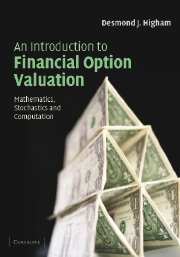Book contents
- Frontmatter
- Contents
- List of illustrations
- Preface
- 1 Option
- 2 Option valuation preliminaries
- 3 Random variables
- 4 Computer simulation
- 5 Asset price movement
- 6 Asset price model: Part I
- 7 Asset price model: Part II
- 8 Black–Scholes PDE and formulas
- 9 More on hedging
- 10 The Greeks
- 11 More on the Black–Scholes formulas
- 12 Risk neutrality
- 13 Solving a nonlinear equation
- 14 Implied volatility
- 15 Monte Carlo method
- 16 Binomial method
- 17 Cash-or-nothing options
- 18 American options
- 19 Exotic options
- 20 Historical volatility
- 21 Monte Carlo Part II: variance reduction by antithetic variates
- 22 Monte Carlo Part III: variance reduction by control variates
- 23 Finite difference methods
- 24 Finite difference methods for the Black–Scholes PDE
- References
- Index
8 - Black–Scholes PDE and formulas
Published online by Cambridge University Press: 05 June 2012
- Frontmatter
- Contents
- List of illustrations
- Preface
- 1 Option
- 2 Option valuation preliminaries
- 3 Random variables
- 4 Computer simulation
- 5 Asset price movement
- 6 Asset price model: Part I
- 7 Asset price model: Part II
- 8 Black–Scholes PDE and formulas
- 9 More on hedging
- 10 The Greeks
- 11 More on the Black–Scholes formulas
- 12 Risk neutrality
- 13 Solving a nonlinear equation
- 14 Implied volatility
- 15 Monte Carlo method
- 16 Binomial method
- 17 Cash-or-nothing options
- 18 American options
- 19 Exotic options
- 20 Historical volatility
- 21 Monte Carlo Part II: variance reduction by antithetic variates
- 22 Monte Carlo Part III: variance reduction by control variates
- 23 Finite difference methods
- 24 Finite difference methods for the Black–Scholes PDE
- References
- Index
Summary
OUTLINE
sum-of-squares for asset price
replicating portfolio
hedging
Black–Scholes PDE
Black–Scholes formulas for a European call and put
Motivation
At this stage we have defined what we mean by a European call or put option on an underlying asset and we have developed a model for the asset price movement. We are ready to address the key question: what is an option worth? More precisely,
can we systematically determine a fair value of the option at t = 0?
The answer, of course, is yes, if we agree upon various assumptions. Although our basic aim is to value an option at time t = 0 with asset price S(0) = S0, we will look for a function V(S, t) that gives the option value for any asset price S ≥ 0 at any time 0 ≤ t ≤ T. Moreover, we assume that the option may be bought and sold at this value in the market at any time 0 ≤ t ≤ T. In this setting, V(S0, 0) is the required time-zero option value. We are going to assume that such a function V(S, t) exists and is smooth in both variables, in the sense that derivatives with respect to these variables exist. It was mentioned in Section 7.1 that S(t) is not a smooth function of t − it is jagged, without a well-defined first derivative.
- Type
- Chapter
- Information
- An Introduction to Financial Option ValuationMathematics, Stochastics and Computation, pp. 73 - 86Publisher: Cambridge University PressPrint publication year: 2004

